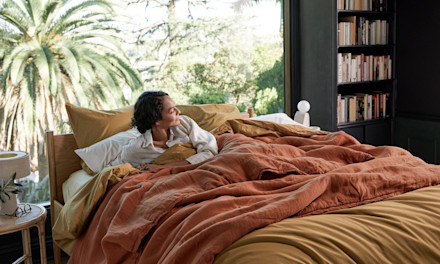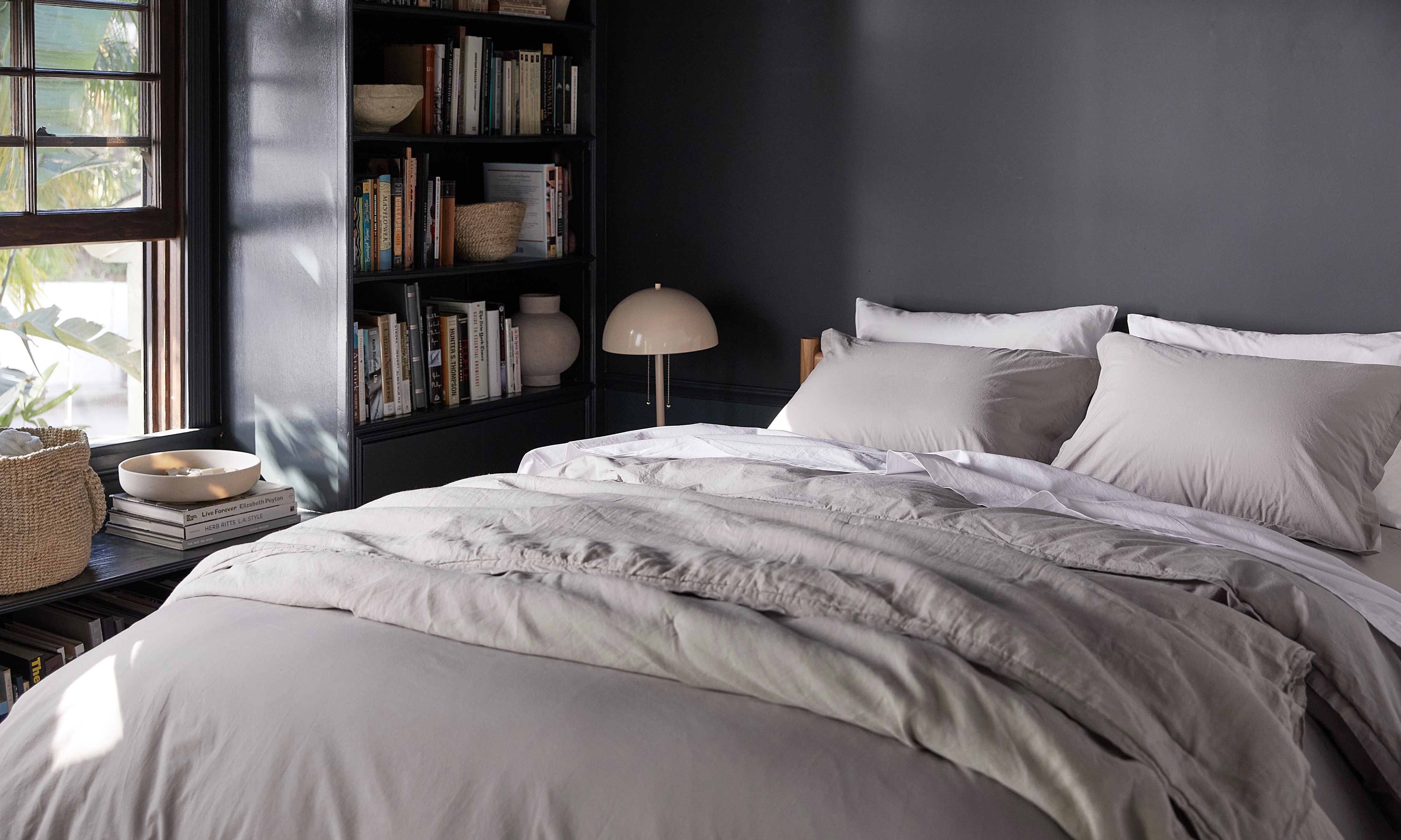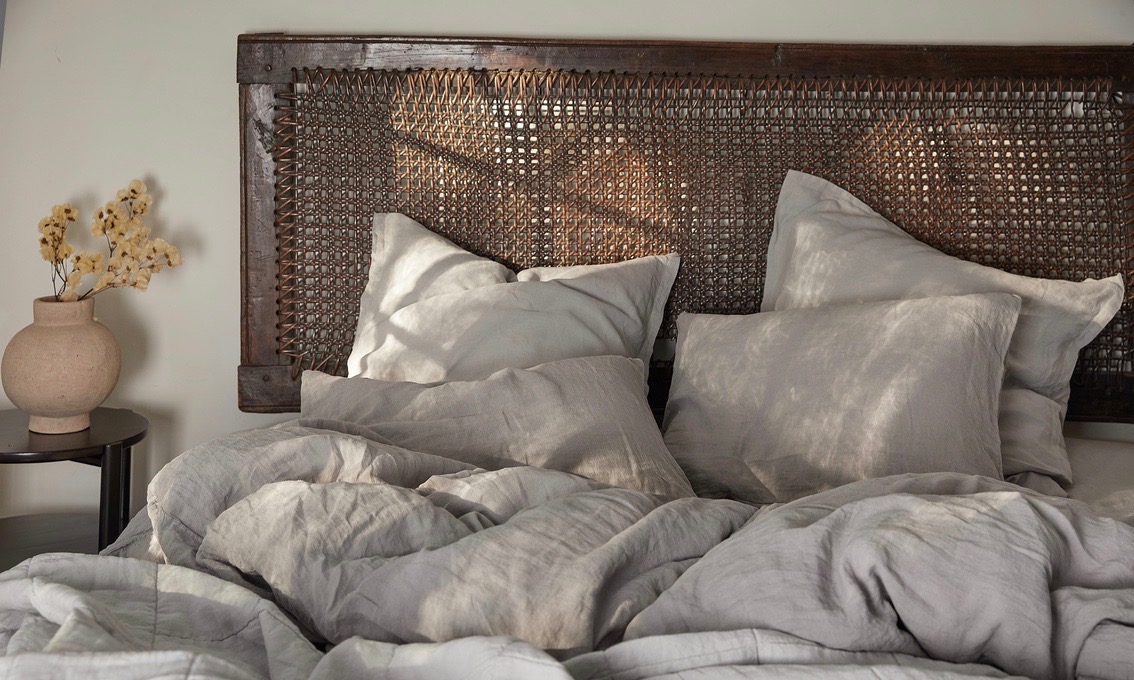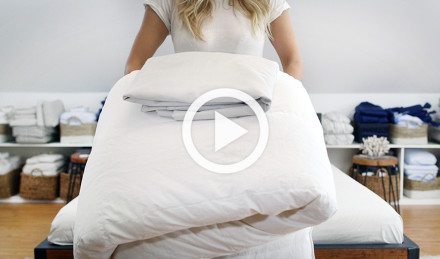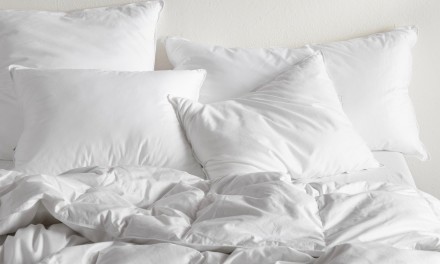When it comes to the best fabrics for bed sheets, cotton and linen are the undisputed frontrunners. The reason for their popularity is that both are natural fibers and possess qualities such as high absorbency and breathability that make them the perfect choice for bedding. But determining which one is best for you is not as easy as it may seem. Picking the right set of bedsheets is a personal decision that has a lot to do with the kind of sleeper you are and the aesthetics you’d like your bedroom to evoke. The textiles manufactured from cotton and linen deliver two distinct experiences both in terms of style and feel.
For a very long time, cotton was the go-to choice for bedding because, in general, it is durable, affordable, soft, easy to care for and is comfortable to sleep on.
Linen, just like cotton, has also been around for millennia. It’s a trendy bedding option because it’s one of the most breathable fabrics on the market and because of its incredibly chic look that oozes effortless elegance and coziness.
To help you decide which fabric is better for your home, we put together a handy guide that describes the similarities and differences of cotton vs linen sheets and the types of bedding manufactured from both.
What is Linen?
Linen is a very durable, lightweight fabric produced from the stem of the flax plant. Linen is a notoriously strong fiber. It’s three times stronger than cotton (the Bureau of Engraving and Printing even uses it to make bills) so you can expect your linen sheets to last for many years.
What is Linen?
Linen is a very durable, lightweight fabric produced from the stem of the flax plant. Linen is a notoriously strong fiber. It’s three times stronger than cotton (the Bureau of Engraving and Printing even uses it to make bills) so you can expect your linen sheets to last for many years.
Because of the natural qualities of flax, linen bedding gets softer as the fabric ages. Of all bedding materials, linen is also the most cooling one because of its looser weave. And since it’s incredibly moisture-resistant, too — it can absorb up to 20 percent of its weight — linen bedding is ideal for those who live in warmer climates or those who prefer to stay cool at night. Moreover, linen is hypoallergenic, so if you have sensitive skin or suffer from any skin conditions or allergies, it will feel soothing on your skin.
For more details on this ultra-cozy fabric, explore our guides:
Because of the natural qualities of flax, linen bedding gets softer as the fabric ages. Of all bedding materials, linen is also the most cooling one because of its looser weave. And since it’s incredibly moisture-resistant, too — it can absorb up to 20 percent of its weight — linen bedding is ideal for those who live in warmer climates or those who prefer to stay cool at night. Moreover, linen is hypoallergenic, so if you have sensitive skin or suffer from any skin conditions or allergies, it will feel soothing on your skin.
For more details on this ultra-cozy fabric, explore our guides:
Cleaning and Caring for Linen Sheets
Caring for your linen bed sheets is also easy. Wash them in cold water with mild detergent and tumble low dry. If you plan on ironing them, a good tip is to take them out of the dryer when they are slightly damp and iron on low heat.
Speaking of ironing, keep in mind that linen tends to wrinkle quite a bit. But some people find that this also adds a dose of casual elegance to the fabric, a unique live-in look and feel that no other material has.
Cleaning and Caring for Linen Sheets
Caring for your linen bed sheets is also easy. Wash them in cold water with mild detergent and tumble low dry. If you plan on ironing them, a good tip is to take them out of the dryer when they are slightly damp and iron on low heat.
Speaking of ironing, keep in mind that linen tends to wrinkle quite a bit. But some people find that this also adds a dose of casual elegance to the fabric, a unique live-in look and feel that no other material has.
What is Cotton?
Cotton is a staple fabric spun from the fibers of cotton plants. People around the world have been cultivating it for thousands of years. One of the earliest bits of cotton is at least 7,000 years old and was found in Mexico. In Egypt and Pakistan, people were weaving cotton thread into clothing in 3,000 BC. And in the 18th century, the British first found a way to spin cotton into textile with machinery.
Cotton is a plant that loves warmer weather and it takes several months for it to produce the fluffy cotton balls that we all know. After the plants are harvested, they are defoliated and send to the cotton gin. There, the cotton fibers are combed — this is done for cleaning and fiber straightening purposes — and then spun into yarn.
What is Cotton?
Cotton is a staple fabric spun from the fibers of cotton plants. People around the world have been cultivating it for thousands of years. One of the earliest bits of cotton is at least 7,000 years old and was found in Mexico. In Egypt and Pakistan, people were weaving cotton thread into clothing in 3,000 BC. And in the 18th century, the British first found a way to spin cotton into textile with machinery.
Cotton is a plant that loves warmer weather and it takes several months for it to produce the fluffy cotton balls that we all know. After the plants are harvested, they are defoliated and send to the cotton gin. There, the cotton fibers are combed — this is done for cleaning and fiber straightening purposes — and then spun into yarn.
Egyptian Cotton
Just like with most things, though, not all cotton plants are created equal. Egyptian cotton that grows along the Nile River produces the highest quality textiles because of its extra-long staples.
Egyptian cotton can be spun into percale, which makes the softest, most luxurious type of bed sheets. Percale is extremely lightweight and perfect for those looking for cooling sheets since it doesn’t retain heat. It has a natural matte finish that results in a clean, crisp look.
Egyptian Cotton
Just like with most things, though, not all cotton plants are created equal. Egyptian cotton that grows along the Nile River produces the highest quality textiles because of its extra-long staples.
Egyptian cotton can be spun into percale, which makes the softest, most luxurious type of bed sheets. Percale is extremely lightweight and perfect for those looking for cooling sheets since it doesn’t retain heat. It has a natural matte finish that results in a clean, crisp look.
Sateen Cotton
Another beautiful cotton fabric is sateen. It has a very delicate sheen that gives it its signature 5-star silky look and feel. Sateen bedding tends to be heavier and thicker than percale because of its weave so it’s the ideal bedding option for those looking for an extra warm layer at night. Because of its silky finish, sateen will give your bedroom a major luxury update.
Sateen Cotton
Another beautiful cotton fabric is sateen. It has a very delicate sheen that gives it its signature 5-star silky look and feel. Sateen bedding tends to be heavier and thicker than percale because of its weave so it’s the ideal bedding option for those looking for an extra warm layer at night. Because of its silky finish, sateen will give your bedroom a major luxury update.
Brushed Cotton
And finally, brushed cotton is for those looking for something in the middle in terms of cooling/heat-retaining qualities. To turn cotton into brushed cotton, the fabric undergoes a couple of extra treatments that result in the softest flannel-like bedlinen. While both percale and sateen sheets may take a few washes to become more supple and soft, a new set of brushed cotton bedding feels like you’ve slept in it forever. It is a great year-round option because it won’t warm or cool you down excessively.
All cotton fabrics share one essential quality: they are moisture-wicking, meaning that, at night, they will absorb any perspiration leaving your body dry and refreshed. Also, they are very easy to care for and don’t require any special dry cleaning treatments. Simply wash your bedding in cool water using mild detergent and tumble dry low. And avoid any bleaching agents.
Brushed Cotton
And finally, brushed cotton is for those looking for something in the middle in terms of cooling/heat-retaining qualities. To turn cotton into brushed cotton, the fabric undergoes a couple of extra treatments that result in the softest flannel-like bedlinen. While both percale and sateen sheets may take a few washes to become more supple and soft, a new set of brushed cotton bedding feels like you’ve slept in it forever. It is a great year-round option because it won’t warm or cool you down excessively.
All cotton fabrics share one essential quality: they are moisture-wicking, meaning that, at night, they will absorb any perspiration leaving your body dry and refreshed. Also, they are very easy to care for and don’t require any special dry cleaning treatments. Simply wash your bedding in cool water using mild detergent and tumble dry low. And avoid any bleaching agents.
Linen vs Cotton: Which Material is Right for You?
Both linen and cotton make excellent bedding fabrics and share quite a few similarities — most notably their water-absorbent qualities and that refreshing, airy feeling. But there are quite a few differences as well, and being aware of them can make it easier for you to choose between the two.
First of all, because linen’s flax fibers are slightly longer than those of cotton and wrapped a little tighter, linen sheets are stronger which means they will last much longer. If softness is a factor for you, you may want to consider cotton, though. Flax fibers are much rougher than cotton resulting in slightly crisper fabric. But the great thing about linen is that it gets softer after each wash, so essentially it gets better with time.
Linen vs Cotton: Which Material is Right for You?
Both linen and cotton make excellent bedding fabrics and share quite a few similarities — most notably their water-absorbent qualities and that refreshing, airy feeling. But there are quite a few differences as well, and being aware of them can make it easier for you to choose between the two.
First of all, because linen’s flax fibers are slightly longer than those of cotton and wrapped a little tighter, linen sheets are stronger which means they will last much longer. If softness is a factor for you, you may want to consider cotton, though. Flax fibers are much rougher than cotton resulting in slightly crisper fabric. But the great thing about linen is that it gets softer after each wash, so essentially it gets better with time.
Linen vs Cotton for Cooling
If you compare linen vs cotton sheets in terms of breathability, another major difference emerges — linen will keep you much cooler at night because of its longer fibers and, therefore, looser weave. Air can pass through linen more easily, keeping your body cool. Cotton, as previously discussed, can also be perfect for warm sleepers (in the case of percale bedding), but linen definitely has the edge over it.
And if you are concerned with style, one thing to keep in mind is that once fitted to a pillow or a mattress, sateen and percale cotton bedding keep its shape much better, resulting in a cleaner wrinkle-free look.
Need more help finding the best cooling sheets for you? Explore these helpful resources:
Linen vs Cotton for Cooling
If you compare linen vs cotton sheets in terms of breathability, another major difference emerges — linen will keep you much cooler at night because of its longer fibers and, therefore, looser weave. Air can pass through linen more easily, keeping your body cool. Cotton, as previously discussed, can also be perfect for warm sleepers (in the case of percale bedding), but linen definitely has the edge over it.
And if you are concerned with style, one thing to keep in mind is that once fitted to a pillow or a mattress, sateen and percale cotton bedding keep its shape much better, resulting in a cleaner wrinkle-free look.
Need more help finding the best cooling sheets for you? Explore these helpful resources:
Styling Your Bed with Linen or Cotton
And speaking of looks, linen sheets have increased in popularity in recent years because they are inherently more boho chic than cotton. Stylists and the Instagram-obsessed love them for their deep texture and camera-friendly looks. They ooze that effortless je ne sais quoi that people associate with French style — unpretentious but impossibly chic.
Cotton sheets have a more traditional, preppy vibe. Percale and brushed cotton are best suited for rooms with a classic décor, while sateen sheets would perfectly complement a more modern bedroom.
Styling Your Bed with Linen or Cotton
And speaking of looks, linen sheets have increased in popularity in recent years because they are inherently more boho chic than cotton. Stylists and the Instagram-obsessed love them for their deep texture and camera-friendly looks. They ooze that effortless je ne sais quoi that people associate with French style — unpretentious but impossibly chic.
Cotton sheets have a more traditional, preppy vibe. Percale and brushed cotton are best suited for rooms with a classic décor, while sateen sheets would perfectly complement a more modern bedroom.
What Products Should You Choose?
At Parachute, you’ll find a large selection of bedding crafted in both linen and cotton. The linen is garment-washed so it’s perfectly soft from the get-go. To make your bed more inviting and your comforter even cozier, opt for a Linen Duvet Cover that could be perfectly styled with a square Linen Euro Sham and a Linen Sham Set. A simple linen pillow cover can add so much character to your bed. For a unique look, you can mix and match the colors, or you can opt for a monochrome look and choose a Linen Duvet Cover Set that comes in three sizes and ten shade options (blushed linen is an extremely popular option). Don’t forget to top your bed with a beautiful Linen Quilt that will add more texture to your bedroom. You can check out our entire linen collection at Parachute’s linen bedding page.
Parachute’s cotton bedding is divided by material such as percale, sateen and brushed cotton. You’ll find everything from fitted and top sheets in all fabrics to duvet covers and multiple top-of-bed options to match your style. If you’re not a fan of buying separates, you can also opt for an entire bundle set that includes everything you’ll need to make the perfect bed.
What Products Should You Choose?
At Parachute, you’ll find a large selection of bedding crafted in both linen and cotton. The linen is garment-washed so it’s perfectly soft from the get-go. To make your bed more inviting and your comforter even cozier, opt for a Linen Duvet Cover that could be perfectly styled with a square Linen Euro Sham and a Linen Sham Set. A simple linen pillow cover can add so much character to your bed. For a unique look, you can mix and match the colors, or you can opt for a monochrome look and choose a Linen Duvet Cover Set that comes in three sizes and ten shade options (blushed linen is an extremely popular option). Don’t forget to top your bed with a beautiful Linen Quilt that will add more texture to your bedroom. You can check out our entire linen collection at Parachute’s linen bedding page.
Parachute’s cotton bedding is divided by material such as percale, sateen and brushed cotton. You’ll find everything from fitted and top sheets in all fabrics to duvet covers and multiple top-of-bed options to match your style. If you’re not a fan of buying separates, you can also opt for an entire bundle set that includes everything you’ll need to make the perfect bed.
When in Doubt, Talk to a Stylist
If you’re still feeling overwhelmed by all the choices, that’s okay. Parachute offers complementary styling consultations that will help you make the best decision for you and your home. You can chat with a stylist on Zoom or by phone to receive personalized advice on the types of bedding and fabrics best suited for you. All you have to do is make an appointment online and send your stylist inspiration photos before your chat so he or she can get a better idea about your style preferences.
A good night’s sleep starts with the right set of bed sheets, so it’s important to know all your options. You can also check out our styling guide for more inspiration. When it comes to cotton vs linen sheets, Parachute carries an extensive line of bedding crafted in both fabrics, ensuring that you will find the best and most comfortable sheets for you.
Read on:
When in Doubt, Talk to a Stylist
If you’re still feeling overwhelmed by all the choices, that’s okay. Parachute offers complementary styling consultations that will help you make the best decision for you and your home. You can chat with a stylist on Zoom or by phone to receive personalized advice on the types of bedding and fabrics best suited for you. All you have to do is make an appointment online and send your stylist inspiration photos before your chat so he or she can get a better idea about your style preferences.
A good night’s sleep starts with the right set of bed sheets, so it’s important to know all your options. You can also check out our styling guide for more inspiration. When it comes to cotton vs linen sheets, Parachute carries an extensive line of bedding crafted in both fabrics, ensuring that you will find the best and most comfortable sheets for you.
Read on:
